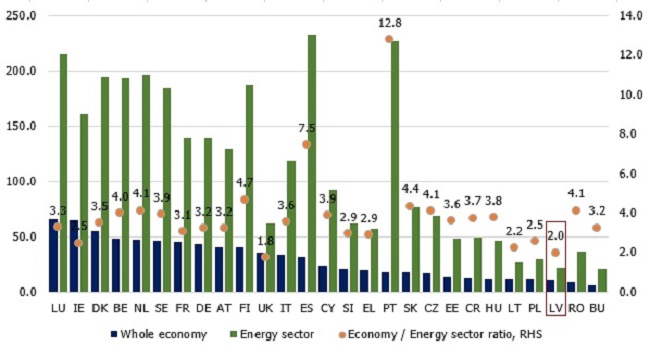Analytics, Direct Speech, Energy, EU – Baltic States, Latvia
International Internet Magazine. Baltic States news & analytics
Monday, 15.12.2025, 00:42
Latvia’s energy sector: challenges and prospects
 Print version
Print version |
|---|
Despite having grown over time and remaining twice as productive as the economy on average (Figure 1), Latvia's energy sector growth has decoupled from overall economic growth and the sector has gradually lost its share in GDP over the recent decades.

The structural changes in the economy as well as improved energy-efficiency could be mentioned among the reasons.
Nevertheless, the value-added created in the economy by using an equivalent energy unit has increased.
One of the most obvious medium-term challenges for Latvia's energy sector is the limited scope for increase in demand given the energy-efficiency goals (for instance, Latvia's residential sector has a large room for improvement here), shrinking population as well as the lack of large-scale projects that would be associated with sizable energy consumption. Insufficient demand in a number of areas in Latvia (for instance, in water supply) manifests itself in the fixed components of energy bills as the costs of infrastructure need to be shared by a smaller number of consumers and limited consumption. The Eurostat data on energy prices suggest that a slight tendency to shift the burden of an increase in unit price of electrical energy to households rather than to industrial consumers has been evident across the EU since 2010.
Liberalised markets, better developed infrastructure and deeper regional integration provide an access to a larger market, at the same time aggravating rivalry. It means that energy production costs remain among the key issues when aiming for higher shares of energy produced from renewables as well as designing support mechanisms for renewable energy producers.
So far, Latvia has reached one of the highest shares of renewables in total energy consumption within the EU, given its natural advantages such as water resources.
However, a further increase in energy production from renewables (including wind power) poses the question of how to deal with the daily and seasonal volatility of supply that maintains the need for adequate balancing base-load capacities (for instance, combined heat and power plants). This might lead to an underuse of these capacities in terms of one of the energy types produced and result in higher maintenance costs. The future support mechanism for renewables as their share in total energy consumption is supposed to increase is also unclear.
Nevertheless, even with the competitiveness issues of the energy sector aggravating, neither the decreasing population nor the increasing energy-efficiency or its future targets as well as regional and global climate targets doom Latvia's energy sector to stagnation. All those developments provide a number of opportunities as well. For instance, searching for new technical solutions for generating capacities provides growth opportunities for both the energy sector as well as scientific research and manufacturing to satisfy national, regional or global market needs. This does not preclude the possibility of launching some large-scale industrial projects that would generate additional consumption either.








 «The Baltic Course» Is Sold and Stays in Business!
«The Baltic Course» Is Sold and Stays in Business!

